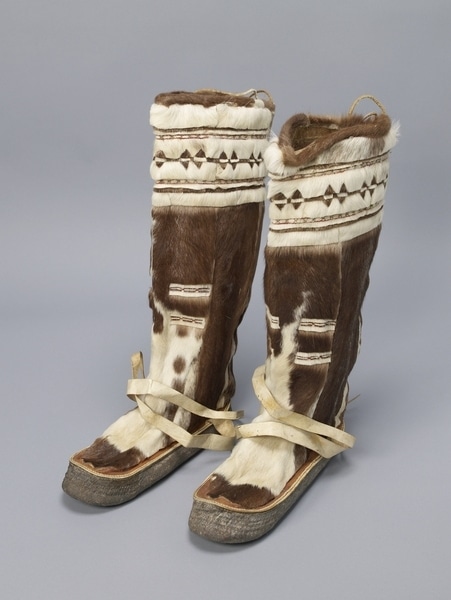Boots Item Number: 565/4 a-b from the MOA: University of British Columbia


Description
Pair of boots made of brown and white caribou fur. The sole is made of dehaired seal skin and the boots are boat-like with vertical crimps. Between the sole and the upper section of the boots a narrow strip of red-brown depilated skin is sewn. The leg section consists of brown and white coloured vertical strips of caribou fur. In the front of the boots four horizontal pieces of decorative trim consisting of brown and white fur and red cloth, are inserted. Above this section of the boots there is a horizontal broad decorated band of brown and white caribou fur, red cloth and embroidery in blue thread. The top of each boot has a casing of brown caribou fur with a leather cord strung through it. To both sides of the foot a dehaired strip of skin is attached.
History Of Use
Boots were worn over skin stockings.
The decorative bands on the boots are known as “Delta trim”. This type of decoration spread east from the MacKenzie Delta area and is now found all over the north. Later these types of decorations were made with coloured cotton bias tape. The fur used in the decorative trim is shaved to make a more clear and crisp pattern.
The insulating capability of animal skins is enhanced by the practice of wearing two layers of skin clothing, especially in winter. One layer of clothing is worn with the fur on the inside and a second layer is worn with the fur on the outside. The clothing also is designed so as to minimize ingress of wind and cold. During winter men and women wear two hooded waist-length coats, two pairs of trousers, two pairs of stockings and boots, and mittens. Men often wear a longer, heavier outer coat when outdoors in winter. While mass-produced clothing from the south is now commonly worn, the making of skin clothing is being revived in the Arctic.
In the Arctic, the making of clothing is considered as important as the creation of sacred objects. Aside from its important function as protection against the cold, clothing is imbued with power and spirituality. Women as seamstresses play an extremely important role in the expression of cultural value and meaning. The clothing of each group is cut and decorated according to distinctive cultural aesthetics. In addition to expressing the group’s identity, seamstresses express the beliefs and values of the group through clothing, which marks social identities like gender, age, childbearing status, and geographical origin. Clothing also expresses the special relationship of people in the Arctic with the animal world. People, animals, and spirits are subject to metamorphosis. Clothing often refers to this ability to transform, and could effect such a metamorphosis.
Cultural Context
footwear
Specific Techniques
Before crimping, the soles are moisturized. To begin crimping the seamstress folds the sole in half longitudinally. The crimps are made by hand and pinched between index finger and thumb and between the teeth. Crimps are about 3 to 4 cm. long and 0.1 cm. apart throughout the toe and heel area. The soles are sewn to a narrow side strip of depilated skin with a running stitch incorporating a thread that is placed on top of the side strip to reinforce the stitches. The other pieces of the boots are sewn together with an overcast stitch. The decorative bands on the boots are known as “Delta trim”. This type of decoration spread east from the MacKenzie Delta area and is now found all over the north. Later these types of decorations were made with coloured cotton bias tape. The fur used in the decorative trim is shaved to make a more clear and crisp pattern.
Item History
- Made in Nunavut, Canada ? before 1914
- Collected in Great Slave Lake, Northwest Territories, Canada before 1914
- Owned by T. P. O'Kelly
- Owned by Evelyn O'Neil before October 18, 1979
- Received from Evelyn O'Neil (Donor) on November 9, 1979
What
Who
- Culture
- Inuit: Inuinnait
- Previous Owner
- T. P. O'Kelly and Evelyn O'Neil
- Received from
- Evelyn O'Neil (Donor)
Where
- Holding Institution
- MOA: University of British Columbia
- Made in
- Nunavut, Canada ?
- Collected in
- Great Slave Lake, Northwest Territories, Canada
When
- Creation Date
- before 1914
- Collection Date
- before 1914
- Ownership Date
- before October 18, 1979
- Acquisition Date
- on November 9, 1979
Other
- Item Classes
- textiles
- Condition
- good
- Current Location
- Case 48
- Accession Number
- 0565/0004 a-b